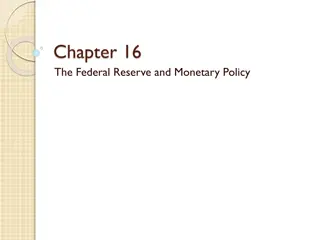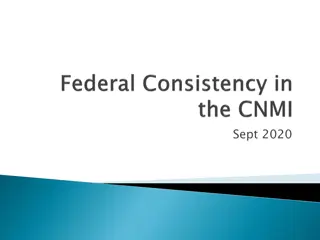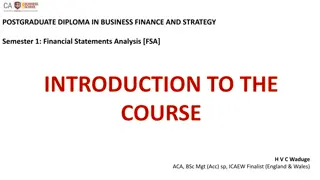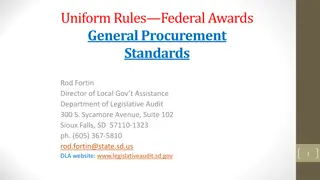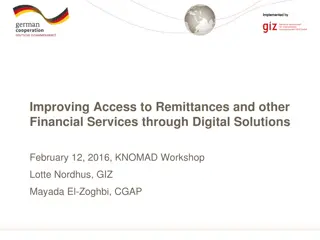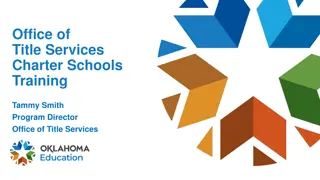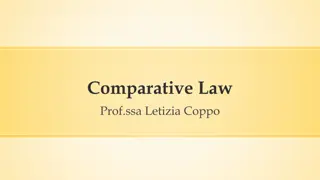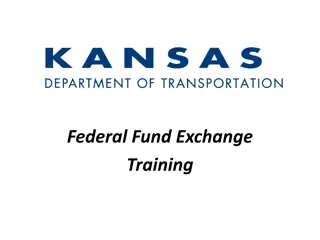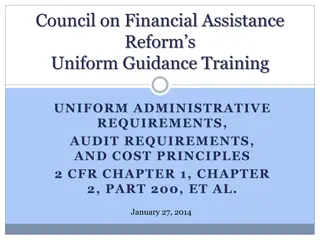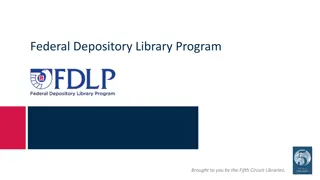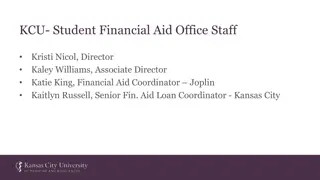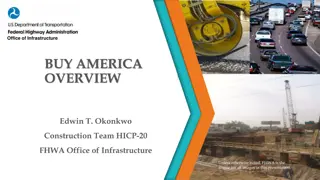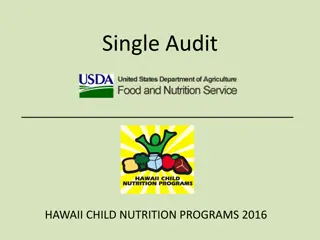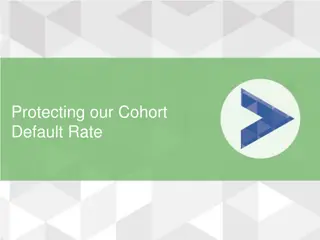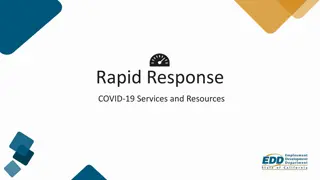Financial Management of Federal Programs Overview
This presentation covers various aspects of financial management in federal programs, such as written policies, best practices, key resources, and examples of references to procedures. It emphasizes the importance of maintaining policies and procedures to ensure compliance with regulations and efficient program administration.
Download Presentation

Please find below an Image/Link to download the presentation.
The content on the website is provided AS IS for your information and personal use only. It may not be sold, licensed, or shared on other websites without obtaining consent from the author.If you encounter any issues during the download, it is possible that the publisher has removed the file from their server.
You are allowed to download the files provided on this website for personal or commercial use, subject to the condition that they are used lawfully. All files are the property of their respective owners.
The content on the website is provided AS IS for your information and personal use only. It may not be sold, licensed, or shared on other websites without obtaining consent from the author.
E N D
Presentation Transcript
Financial Management of Federal Programs Financial Management Division Office of Block Grant Assistance Slide 1
Topics Overview Written Local Policies and Procedures Program Timeliness Cost Principles and Procedures - 2 CFR Part 200, Subpart E Internal Controls
Best Practices or Considerations for Developing Local Policies and Procedures Assess all local policies and processes and made necessary revisions to support the community goals Maintain a library of policies and procedures on your CDBG website to ensure that new information is easily accessible for your subrecipients and new staff. This will ensure increased compliance with CDBG regulations. For higher risk, do an interim and close-out monitoring, especially for procurement, environmental, relocation and special grant provisions. Ensure that policies and procedures are being met. Then, during the close out, do income certification. Staff time spent for the development of general CDBG program policies and procedures such as the monitoring of overall program performance counts towards general program administration.
Key Resource: CPD Monitoring Handbook CHAPTER 34: 2 CFR PART 200, UNIFORM ADMINISTRATIVE REQUIREMENTS, COST PRINCIPLES, AND AUDIT REQUIREMENTS FOR FEDERAL AWARDS Exhibit 34-1 - Guide for Review of Financial Management and Audits Exhibit 34-1A - Guide for Review of Financial Management and Audits Exhibit 34-2 - Guide for Review of Cost Allowability Exhibit 34-2A - Guide for Review of Cost Allowability Exhibit 34-3 - Guide for Review of Procurement Exhibit 34-3A - Guide for Review of Procurement Exhibit 34-4 - Guide for Review of Equipment Management and Equipment Disposition
Examples of References to Procedures For example, do the non-Federal entity's procedures preclude one person from issuing purchase orders, receiving merchandise, and approving payment vouchers? If the state transfers grant funds to subrecipients under a HUD award that is subject to subpart B, does the state have procedures to minimize the time elapsing between the receipt of funds from the Federal government and the transfer of funds to the subrecipients? If the recipient is not a state and transfers grant funds to subrecipients, does the recipient have procedures to minimize the time elapsing between the receipt of funds from the Federal government and the transfer of funds to the subrecipients?
Basis for CDBG Timeliness Process HUD has a statutory requirement, found at Section 104(e)(1) of the HCDA that directs the agency, at least on an annual basis to determine whether the grantee has carried out its activities in a timely manner and whether the grantee has a continuing capacity to carry out those activities in a timely manner.
Timeliness Regulation 24 CFR 570.902 implements the statutory requirement Establishes 1.50 as the ratio for all entitlement grantees to meet 60 days prior to end of program year (insular areas to meet 2.00 60-day ratio)
Pre-Pandemic Timeliness Process Established in November 2001 with the Bernardi memo Use it or lose it policy if a grantee does not use its funds in a timely manner, its grant will be reduced First year warning letter; second consecutive year grant reduction Exceptions only allowed for circumstances beyond a grantee s reasonable control Further strengthened in January 2017 following 2013 OIG audit that recommended that CPD establish written procedures and improve its documentation, particularly regarding sanction/exception determinations for twice-untimely grantees
Timeliness During FY20-21 Corrective actions suspended in the CDBG-CV Notice, effective January 21, 2020 Suspension does not eliminate timeliness regulation at 24 CFR 570.902 HUD still ran reports and notified grantees of deficiencies Suspension was extended several times in 2020 and 2021 and expired on September 30, 2021
Overall Ongoing Grantee Compliance For the vast majority of grantees, timely expenditure is not an issue December 31, 2019, last test date before the pandemic August 2, 2021, last test date before the corrective actions suspension was lifted. 12/31/2019 Test Date 8/2/2021 Test Date 10.6% Untimely 38.9% Untimely
Restarting the Corrective Actions Process for Untimely Expenditure October 21, 2021 memo: Restarting the Corrective Actions Process for Untimely Expenditure https://www.hud.gov/program_offices/comm_planning/cdbg Goal: To address the expenditure challenges that many grantees are facing right now and to lessen the administrative burdens on HUD personnel in Headquarters and the Field. 1. 2. The corrective action suspension for violations of the CDBG timeliness standard has ended. Corrective Action procedures have been modified
Modification CDBG Timeliness Corrective Actions for the Next Two Years For most grantees, FY 2019, FY 2022, and FY 2023 are treated as consecutive years. However, for grantees with a January 1, February 1, and March 1 program year start dates (i.e. timeliness test pre-1/21/2020), FY 2020, FY 2022, and FY 2023 will be treated as consecutive years. HUD will not factor into the potential corrective action the timeliness status of grantees for FY 2020 (post 1/21/2020) and FY 2021. In effect for a two-year period: Begin October 1, 2021(FY2022) and conclude on September 30, 2023 (FY 2023)
The New Process CDBG Timeliness Status Table (2/1/2020 Test Date or later) Grantee timeliness status in FY19 on its test date Timely Action taken if untimely in FY 2022 Action taken if still untimely in FY2023 Sent warning letter Required to submit workout plan A Untimely for the first time Untimely for the second consecutive year or more Required to submit workout plan Invited to informal consultation B Invited to informal consultation Invited to informal consultation C
Timeliness Timeline Periods in purple are not factored into the timeliness assessment, unless an untimely grantee became timely during FY 2020 or FY 2021. Excluded: 1/21/2020 to 9/30/2020 Excluded: 10/1/2020 to 9/30/2021 Grantee is untimely on test date: Considered 1st time untimely Grantee is timely
Timeliness Timeline Periods in purple are not factored into the timeliness assessment, unless an untimely grantee became timely during FY 2020 or FY 2021. Excluded: 1/21/2020 to 9/30/2020 Excluded: 10/1/2020 to 9/30/2021 Grantee is still untimely on test date: Considered 2nd time untimely Grantee is untimely for the first time.
Timeliness Timeline Periods in purple are not factored into the timeliness assessment, unless an untimely grantee became timely during FY 2020 or FY 2021. Excluded: 1/21/2020 to 9/30/2020 Excluded: 10/1/2020 to 9/30/2021 Grantee is still untimely on test date: Considered 3rd time untimely; invited to informal consultation Grantee is untimely for the second consecutive year or more.
Other Resources An excellent introduction to the timeliness process and best practices to achieve timeliness can be found on the Explore CDBG page on the HUD Exchange. (click on the video below to watch.)
Cost Principles and Procedures 2 CFR Part 200, Subpart E Indirect Cost Recovery + Allowable Direct Costs + Allocable Indirect Costs Applicable Credits TOTAL Costs of a Federal Award
Composition of Costs ( 200.402) + Allowable Direct Costs + AllocableIndirect Costs Applicable Credits TOTAL Costs of a Federal Award
Factors affecting Allowability ( 200.403) (a) Be necessary and reasonable for the performance of the Federal award and be allocable thereto. (b) Conform to any limitations or exclusions set forth in these principles or in the Federal award as to types or amount of cost items. Necessary Reasonable Consistent Documented (c) Be consistent with policies and procedures that apply uniformly to both federally-financed and other activities of the non-Federal entity. (d) Be accorded consistent treatment. (e) Be determined in accordance with generally accepted accounting principles (GAAP), except, for state and local governments and Indian tribes only, as otherwise provided for in part 200. (f) Not be included as a cost or used to meet cost sharing or matching requirements of any other federally-financed program in either the current or a prior period. + Allowable Direct Costs + AllocableIndirect Costs Applicable Credits TOTAL Costs of a Federal Award (g) Be adequately documented. (h) Cost must be incurred during the approved budget period.
Selected Items of Cost (200.420 - .475) Allowability is not limited to cost items listed Subpart E cost principles apply whether or not an item of cost is treated as direct or indirect In case of a discrepancy between cost principles and provisions of a specific Federal award, the Federal award governs + Allowable Direct Costs + Allocable Indirect Costs Applicable Credits TOTAL Costs of a Federal Award
Document IDC Recover IDC About IDC Classification of Costs (Direct vs Indirect) + Allowable DirectCosts +AllocableIndirect Costs Applicable Credits TOTAL Costs of a Federal Award
Some Background on Cost Classification Costs can be classified in various ways, depending on the purpose. Economists and accountants often find it useful to establish binary classifications of costs. Under such classifications, costs are included in one category or the other (e.g., either direct or indirect).
Allocable Costs (200.405) A cost is allocable to a particular Federal award or other cost objective if it: Is incurred specifically for the Federal award. Benefits both the federal award and other work of the non-Federal entity and is assignable in part to the Federal award in accordance with the Cost Principles in 2 CFR 200, Subpart E. Is necessary to the overall operation of the non-Federal entity. + Allowable Direct Costs + Allocable Indirect Costs Applicable Credits TOTAL Costs of a Federal Award
Document IDC Recover IDC About IDC Applicable Credits Examples Definition 200.406 Applicable credits refer to those receipts or reduction-of-expenditure-type transactions that offset or reduce expense items allocable to the Federal award as direct or indirect (F&A) costs. To the extent that such credits accruing to or received by the non-Federal entity relate to allowable costs, they must be credited to the Federal award either as a cost reduction or cash refund, as appropriate. purchase discounts rebates or allowances recoveries or indemnities on losses insurance refunds or rebates adjustments of overpayments or erroneous charges + Allowable Direct Costs + Allocable Indirect Costs Applicable Credits TOTAL Costs of a Federal Award
Direct Costs Definition 200.413 Direct costs.(a) General. Direct costs are those costs that can be identified specifically with a particular final cost objective, such as a Federal award, or other internally or externally funded activity, or that can be directly assigned to such activities relatively easily with a high degree of accuracy. Examples Salaries, wages, and related fringe benefits of employees directly performing services related to a specific project or cost objective Travel costs incurred in the performance of direct services supported by Federal award Equipment and other approved capital expenditures for approved project/activity Costs incurred for the same purpose in like circumstances must be treated consistently as either direct or indirect (F&A) costs. +Allowable Direct Costs + AllocableIndirect Costs Applicable Credits TOTAL Costs of a Federal Award
Document IDC Recover IDC About IDC Indirect (F&A) Costs Examples Definitions 200.414 - Indirect (F&A) costs means those costs incurred for a common or joint purpose benefitting more than one cost objective, and not readily assignable to the cost objectives specifically benefitted, without effort disproportionate to the results achieved. General and Administrative salaries and wages Office building security services Office supplies Depreciation Indirect costs can be defined as any costs incurred by a recipient or subrecipient that cannot be traced directly to a cost objective. Rent + Allowable Direct Costs + Allocable Indirect Costs Applicable Credits TOTAL Costs of a Federal Award
Document IDC Recover IDC About IDC Classification of Indirect (F&A) Costs For awards to: - major Institutions of Higher Education - major nonprofit organizations Indirect costs must be classified into two categories: 1. Facilities 2. Administration + Allowable Direct Costs + Allocable Indirect Costs Applicable Credits TOTAL Costs of a Federal Award
Document IDC Recover IDC About IDC Facilities and Administration (F&A) Categories of Indirect Costs Definitions 200.414 Facilities and administration classification. (a) General. Facilities is defined as depreciation on buildings, equipment and capital improvement, interest on debt associated with certain buildings, equipment and capital improvements, and operations and maintenance expenses. Administration is defined as general administration and general expenses such as the director's office, accounting, personnel and all other types of expenditures not listed specifically under one of the subcategories of Facilities (including cross allocations from other pools, where applicable) Applicability to Types of Awards For nonprofit organizations, library expenses are included in the Administration category. o Major nonprofit organizations are those which receive more than $10 million dollars in direct Federal funding. For IHEs, they are included in the Facilities category. o Major IHEs are defined as those required to use the Standard Format for Submission as noted in appendix III to this part, and Rate Determination for Institutions of Higher Education paragraph C. 11. + Allowable Direct Costs + Allocable Indirect Costs Applicable Credits TOTAL Costs of a Federal Award
Document IDC Recover IDC About IDC Diversity of Nonprofits 200.414(b) Diversity of Nonprofit Organizations. It is not possible to specify the types of cost which may be classified as indirect (F&A) cost in all situations. Identification with a Federal award rather than the nature of the goods and services involved is the determining factor in distinguishing direct from indirect (F&A) costs of Federal awards. Examples of Indirect Costs for Nonprofits Depreciation on buildings and equipment Costs of operating and maintaining facilities General administration and general expenses Salaries Expenses of Executive Officers Personnel Administration Accounting + Allowable Direct Costs + Allocable Indirect Costs Applicable Credits TOTAL Costs of a Federal Award
Document IDC Recover IDC About IDC Recovery of Indirect Costs + Allowable Direct Costs + Allocable Indirect Costs Applicable Credits TOTAL Costs of a Federal Award
Document IDC Recover IDC About IDC Key Terms related to IDCs Indirect Costs Cost Objective Indirect Cost Rate 10% De Minimis Rate Central Service Cost Allocation Plan Indirect Cost Rate Proposal Cognizant Agency
Document IDC Recover IDC About IDC Points to Keep in Mind about IDCs Indirect costs tend to be support costs (e.g., telephone, printing, rent) as opposed to costs that can be traced directly to projects or activities (e.g., construction costs for public facilities). Indirect costs are real and have to be paid from some revenue source for an organization to function. For most HUD grantees, allocation of indirect costs does not increase total funding.
Document IDC Recover IDC About IDC Cost Objective Definitions - Cost objective means a program, function, activity, award, organizational subdivision, contract, or work unit for which cost data are desired and for which provision is made to accumulate and measure the cost of processes, products, jobs, capital projects, etc. - A cost objective may be a major function of the non-Federal entity, a particular service or project, a Federal award, or an indirect (F&A) cost activity, as described in Subpart E-Cost Principles. Examples: HUD award, project, or activity.
Document IDC Recover IDC About IDC Indirect Cost Rate Indirect Costs Direct Cost Base Indirect Cost Rate (expressed as a percentage) Acceptable Direct Cost Bases (Denominator): Direct salaries and wages including (or excluding) all fringe benefits. Direct salaries and wages including vacation, holiday, sick pay, and other paid absences but excluding all other fringe benefits. Total Direct Costs (TDC) Modified Total Direct Costs (MTDC)
Document IDC Recover IDC About IDC Types of Indirect Cost Rates a temporary indirect cost rate applicable to a specified period which is used for funding, interim reimbursement, and reporting indirect costs on Federal awards pending the establishment of a "final" rate for that period. Provisional a permanent rate established after the organization s actual costs for a completed fiscal period are known. The final rate is not subject to adjustment. Final an indirect cost rate, applicable to a specified current or future period, usually the governmental unit's fiscal year. This rate is based on an estimate of the costs to be incurred during the period. Except under very unusual circumstances, a predetermined rate is not subject to adjustment. Predetermined an indirect cost rate which has the same characteristics as a predetermined rate, except that the difference between the estimated costs and the actual, allowable costs of the period covered by the rate is carried forward as an adjustment to the rate computation of a subsequent period. Fixed (with carry forward)
Document IDC Recover IDC About IDC 10% De Minimis Rate 200.414 Indirect (F&A) costs (f) In addition to the procedures outlined in the appendices in paragraph (e) of this section, any non-Federal entity that does not have a current negotiated (including provisional) rate, except for those non-Federal entities described in appendix VII to this part, paragraph D.1.b, may elect to charge a de minimis rate of 10% of modified total direct costs (MTDC) which may be used indefinitely. No documentation is required to justify the 10% de minimis indirect cost rate. As described in 200.403, costs must be consistently charged as either indirect or direct costs but may not be double charged or inconsistently charged as both. If chosen, this methodology once elected must be used consistently for all Federal awards until such time as a non-Federal entity chooses to negotiate for a rate, which the non-Federal entity may apply to do at any time.
Document IDC Recover IDC About IDC 10% De Minimis Rate cont d Modified Total Direct Cost (MTDC) MTDC means all direct salaries and wages, applicable fringe benefits, materials and supplies, services, travel, and up to the first $25,000 of each subaward (regardless of the period of performance of the subawards under the award). MTDC excludes equipment, capital expenditures, charges for patient care, rental costs, tuition remission, scholarships and fellowships, participant support costs and the portion of each subaward in excess of $25,000. Other items may only be excluded when necessary to avoid a serious inequity in the distribution of indirect costs, and with the approval of the cognizant agency for indirect costs.
Document IDC Recover IDC About IDC Modified Total Direct Cost (MTDC) Applicable Fringe Benefits Capital Expenditures Charges for Patient Care Equipment Direct salaries Wages Tuition Remission Materials and Supplies Rental Costs Scholarships Services Travel Portion of each subaward > $25k Participant Support Costs Up to $25k of each subaward Fellowships
Government Wide Central Service Cost Allocation Plan Document IDC Recover IDC About IDC Appendix V to Part 200 State/Local Government-wide Central Service Cost Allocation Plans Governmental units provide certain services to operating departments or agencies on a centralized basis. Plan identifies central service costs and assigns them to operating departments (or other sub-units) on a reasonable and consistent basis Major local gov t means local gov t that receives more than $100 million in direct Federal awards subject to this Part. Examples where Applied Motor Pools Computer Centers Purchasing Accounting
Document IDC Recover IDC About IDC Indirect Cost Rate Proposal (ICRP) Considerations Indirect costs included in ICRP consist of: Indirect cost rate proposal means the documentation prepared by a non-Federal entity to substantiate its request for the establishment of an indirect cost rate as described in appendices III through VII and appendix IX to 2 CFR part 200. - Central service costs allocated to the non- Federal entity (if it is a governmental unit), and - Indirect costs of department/agency/organization Gov t Entity Covers an operating department or agency Nonprofit May cover an entire operation
Document IDC Recover IDC About IDC Indirect Cost Rate Proposal - cont d Typically, the ICRP for a governmental entity covers an operating department or agency. ICRP for nonprofit organization may cover entire operation. Indirect costs included in ICRP consist of: - Central service costs allocated to the unit (if it is a governmental unit), and - Indirect costs of department/agency/organization.
Document IDC Recover IDC About IDC Cognizant Agency Determination Guidance on determining cognizance provided in Appendix V to Part 200 - State/Local Governmentwide Central Service Cost Allocation Plans. NOTE: Cognizance for Central Service Cost Allocation Plan may be different than cognizance for an Indirect Cost Proposal for a department of the governmental unit. Some Federal agencies are always cognizant for certain categories of governmental units (e.g., HUD is cognizant for state and local housing and development districts). If a subrecipient does not receive any funding from any Federal agency, the pass-through entity is responsible for the negotiation of the indirect cost rates in accordance with 200.332(a)(4).
Document IDC Recover IDC About IDC Submission Instructions If HUD is determined to be the cognizant agencyand submission of Central Services Plan or ICRP is required, it should be submitted by the grant recipient to the CPD Division in the appropriate field office. The CPD field office should forward the documentation to HUDCPDIndirectCostRates@hud.gov for submission to the Department of Health and Human Services (HHS).
Document IDC Recover IDC About IDC Recovering Indirect Costs When using a rate specified in ICRP: Submit claims/drawdowns using the rate negotiated with the cognizant agency or the rate in the indirect cost proposal prepared and held for review Apply indirect cost rate to direct cost base (i.e., direct costs incurred under the grant being charged for indirect costs) Maintain documentation for audit purposes
Document IDC Recover IDC About IDC Recovering Indirect Costs cont d When using a 10% de minimis rate: Submit claims/drawdowns using the 10% de minimis rate Apply de minimis rate to MTDC (incurred under grant being charged for indirect costs) Maintain documentation of MTDC for audit purposes
Document IDC Recover IDC About IDC IDC Recovery Limitations Amount recovered may be affected by statutory or regulatory limitations. For example, CDBG recipients may not be able to recover amount of indirect costs otherwise allocable to a grant if it would cause the recipient to exceed the cap on general administrative costs.
Additional Resources Cost Principles and Procedures - 2 CFR Part 200, Subpart E https://www.ecfr.gov/current/title-2/subtitle- A/chapter-II/part-200/subpart-E Appendix IV to Part 200 - Indirect (F&A) Costs Identification and Assignment, and Rate Determination for Nonprofit Organizations: https://www.ecfr.gov/current/title-2/subtitle-A/chapter-II/part-200/appendix- Appendix%20IV%20to%20Part%20200 Appendix V to Part 200 - State/Local Governmentwide Central Service Cost Allocation Plans: https://www.ecfr.gov/current/title-2/subtitle-A/chapter-II/part-200/appendix- Appendix%20V%20to%20Part%20200 Appendix VII to Part 200 -States and Local Government and Indian Tribe Indirect Cost Proposals: https://www.ecfr.gov/current/title-2/subtitle-A/chapter-II/part-200/appendix- Appendix%20VII%20to%20Part%20200 Department of Labor: A Guide for Indirect Cost Rate Determination Applicable to Nonprofit and Commercial Organizations https://www.dol.gov/agencies/oasam/centers-offices/office-of-the-senior- procurement-executive/cost-price-determination-division/guide-for-indirect-cost-rate-determination-for- nonprofit HHS: https://rates.psc.gov/ CPD Monitoring Handbook (6509.2): https://www.hud.gov/program_offices/administration/hudclips/handbooks/cpd/6509.2 Exhibit 34-2a - Guide for Review of Cost Allowability Compliance Supplement (2 CFR PART 200, APPENDIX XI): https://www.whitehouse.gov/wp- content/uploads/2021/08/OMB-2021-Compliance-Supplement_Final_V2.pdf
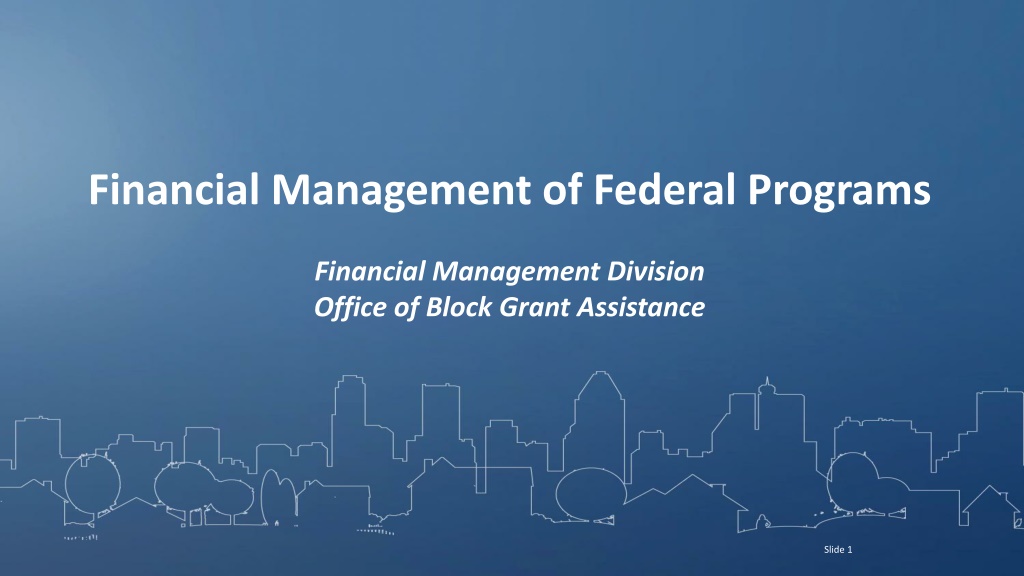


 undefined
undefined
 undefined
undefined
 undefined
undefined



